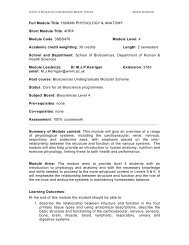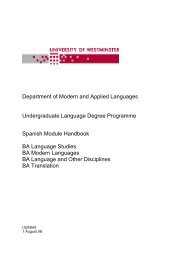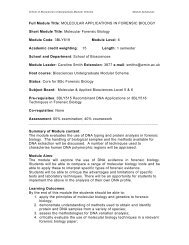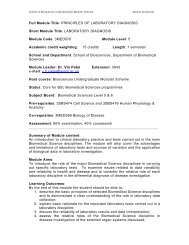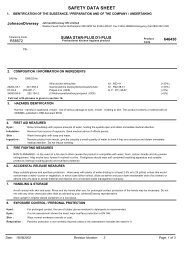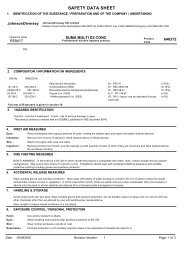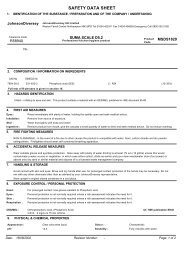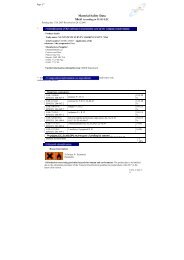CONTENTS 1. Introduction 1.1 Course Outline 1 1.2 Introduction ...
CONTENTS 1. Introduction 1.1 Course Outline 1 1.2 Introduction ...
CONTENTS 1. Introduction 1.1 Course Outline 1 1.2 Introduction ...
Create successful ePaper yourself
Turn your PDF publications into a flip-book with our unique Google optimized e-Paper software.
Full Module Title:<br />
GRAPHICS<br />
Short Module Title: GRAPHICS<br />
Module Code: 2DPI620 Module Level: 6<br />
Academic credit weighting: 15<br />
Length: 1 semester<br />
School:<br />
Media, Art and Design<br />
Department:<br />
Photographic and Digital Media<br />
Module Leader(s): Liz Allen Extension:4083<br />
Host <strong>Course</strong>:<br />
BSc (Hons) Photography and Digital Imaging<br />
Status:<br />
Option<br />
Pre-requisites:<br />
None<br />
Co-requisites:<br />
None<br />
Assessment:<br />
20% Written <strong>Course</strong> work<br />
40% Written Reports / practical assignments<br />
40% Written Examination<br />
Summary of Module content: Computer graphics, Animation, Modelling, Visualisation<br />
The module comprises a series of lectures, practical work and written coursework, which explores the<br />
fundamental processes in 3D computer graphics. The module aims to provide the students with the<br />
fundamental concepts and theories underlying graphics generation, knowledge of the variety of and<br />
future developments of graphics applications, and practical experience in creating 3D graphics,<br />
models and animation.<br />
Module Aims:<br />
• To provide an understanding of the fundamental techniques and concepts used for production of<br />
Graphics.<br />
• To examine methods of computer graphics for image generation and the modelling of objects.<br />
• To equip students to generate imagery and visualise information using computers and computer<br />
graphics.<br />
• To investigate the scope of computer graphics and animation.<br />
Learning Outcomes:<br />
On successful completion of the module, the successful student will:<br />
<strong>1.</strong> Understand fundamental techniques of graphics production.<br />
2. Demonstrate advanced knowledge in computer graphics or visualisation.<br />
3. Be proficient in the use of software for graphics production.<br />
4. Be aware of the scope of graphics in the media and scientific industries.<br />
Indicative syllabus content:<br />
Fundamental processes in 3D computer graphics. Graphics pipeline. Graphics primitives and coordinate<br />
systems. 2D and 3D modelling techniques. 3D transfprmations. Hidden line / surface<br />
removal, lighting and shading models, ray tracing and texture mapping. Animation techniques. Visual<br />
realism. 3D volume visualisation.<br />
Teaching and Learning Methods:<br />
Illustrated lectures (appx 12 hrs). Supervised practical work (approx 24hrs)<br />
Assessment Rationale: The examination is unseen and will test students’ ability to define concepts,<br />
derive results, describe applications and procedures and to analyse and comment on specific case<br />
studies. (Learning outcomes 1,2,4)<br />
Written <strong>Course</strong>work may consist of an essay requiring a detailed and accurate analysis at the<br />
appropriate level, with justifications and appropriate assumptions. Students may consult a range of<br />
sources and assignments are timed to enable valuable feedback. (Learning outcomes 1,2,4)<br />
DPI_Hbook 82 ©University of Westminster





